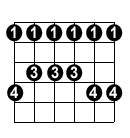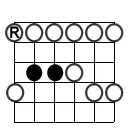Scale diagrams are like a snapshot of your guitar’s fretboard. This lesson will help you to learn to read scale diagrams for guitar. Scale diagrams are a great way to learn new scales.
The black dots show the scale pattern as it appears on the fretboard. The numbers in the black dots show what fingers you should use to finger that note when practicing the scale. The white dots at the top are open strings:
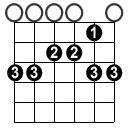
While this may look similar to a chord diagram, it’s not played like a chord. You should practice playing it one note at a time. Start with the lowest note on the low E string and play up the scale until you get to the highest note, then go back down backward.

Movable Patterns Diagrams
Some scale diagrams don’t show you where to play them on the fretboard, only the pattern. They are movable patterns which mean they can be played anywhere on the fretboard depending on what key you are playing in.
Throughout this section, each scale pattern presented has two diagrams. The first diagram will show the pattern with the suggested fingerings. Look at the example below:
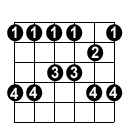
Scale/Chord Relationship
The scale patterns are built around the open position chord that they are named after. The second picture for each scale pattern shows the root and highlights the CAGED chord pattern that the scale pattern is associated with. The white dots and black dots make up the scale pattern, but the black dots show you the chord pattern the pattern is built around.
Look at the example below:
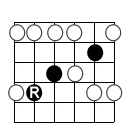
This pattern above is the C scale pattern. With the CAGED chord highlight picture, you can see how the scale pattern relates to the C major chord form.
Below is a diagram of the C major chord form. Can you see the similarities with the C scale pattern?

Root Notes
You’ll notice that there are 12 different key signatures for each scale. That doesn’t mean you have to learn the scale 12 separate times. You only need to learn the different scale patterns. You simply have to move the patterns up or down the fretboard in order to change keys. In the diagram below, you can see a visual representation of a pentatonic minor scale pattern. The root note of the scale is marked by an “R”.
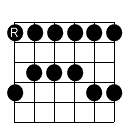
Since the pattern is the same for any key we must simply match the root note to the note on the 6th string that matches the name of the key. See the chart below.
| Fret | 1 | 2 | 3 | 4 | 5 | 6 | 7 | 8 | 9 | 10 | 11 | 12 |
| Key | F | F#/Gb | G | G#/Ab | A | A#/Bb | B | C | C#/Db | D | D#/Eb | E |
As scale pattern can have it’s root note in a different place other than the lowest note. This pentatonic major scale pattern has it’s root note in a place other than the lowest note. It’s the second note on the bottom string as illustrated below:
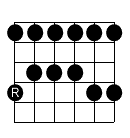
| Fret | 1 | 2 | 3 | 4 | 5 | 6 | 7 | 8 | 9 | 10 | 11 | 12 |
| Chord | – | – | (open) G | G#/Ab | A | A#/Bb | B | C | C#/Db | D | D#/Eb | E |
Since there are 12 different keys signatures you need to know the root of each scale pattern. You will see that each scale pattern shares the same root note as the chord form that is associated with them. The root is marked by an “R” in each chord pattern highlight diagram for each scale pattern like in the example below:

Playing this scale pattern so that the root falls on the 5th fret it would be playing it in the key of D, because the 5th fret of the 5th string (where the root falls) is D. Here it is tabbed out:

The scale patterns have roots on the 6th, 5th, and 4th strings, so being able to identify notes on these strings is important if you want to be able to play them in all 12 key signatures.
Practicing Scale Patterns With Diagrams
Take a look at the minor scale pattern diagrams below:
Now forget the fancy name and look at the actual pattern. Remember that it is a movable pattern, so we can play this anywhere on the neck of the fretboard depending on what key we want to play in.
As an example let’s say we wanted to practice the scale pattern in the
key of G (or Gm). First, we would find our root note which would be the
G note on the 6th string, because the second diagram above shows us that
the root note is on the 6th string (low E). We can either play the G note
on the 3rd fret or an octave higher at the 15th fret.
Okay, so we’ve found our root note and are ready to play up and down
the scale-each note in sequence from the lowest note in the scale to the highest
note in the scale and then back down again. This is how it would be played:

See, if we know that the root note is on the 3rd fret, we know the rest
of the notes in the scale pattern follow in sequence:

Take a look at scale patterns like this: learning one pattern is like learning 12 scales because you can play the pattern in 12 keys.
